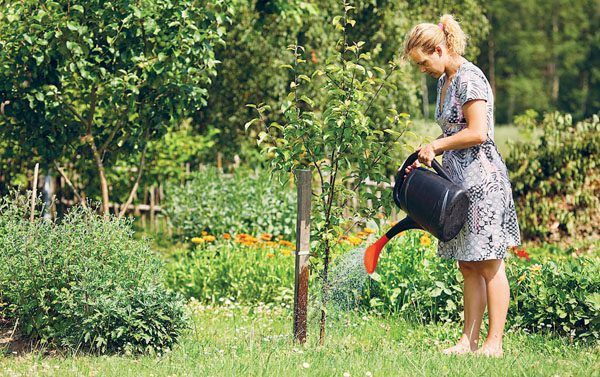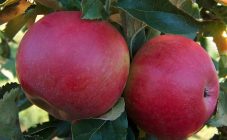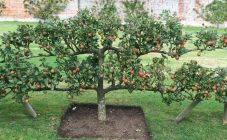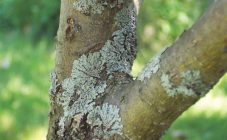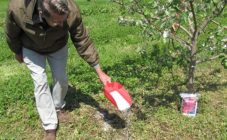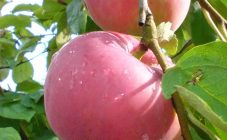Content:
High groundwater levels are almost always detrimental to fruit trees, and the apple tree does not tolerate it particularly well. But there is a way out! The article describes how to plant an apple tree if groundwater is close and options for saving already mature trees.
Does the apple tree love water?
Of course, apple trees, like any others, cannot grow without moisture. The main reason for the disease or even death of an apple tree in high groundwater is a lack of oxygen and a supersaturation of the soil with mineral salts. The situation is also influenced (somewhat less) by other factors - stagnation or mobility of groundwater, the general composition of soils. In any case, when the aquifer is less than 1.5 m, you cannot do without special measures, otherwise the apple trees will hurt and eventually die.
How to determine the depth of groundwater
Usually the depth of the aquifer depends on the terrain. In the lowlands, the level will be higher, on the hillock - on the contrary, higher. Seasonal fluctuations also take place. In spring, especially during snow melting, it is significantly higher.
There are several ways to determine the depth of an aquifer.
- The nearest well. If there is a well near the site, it is easy to see the water level. The method is approximate, your site may be located slightly below the well, or some features will make the water on it a little higher. But in general, if the water level in the well is one and a half meters or even higher, this is an alarming sign.
- Vegetation. Willow and alder, thickets of sedges, cattail and horsetail indicate the close occurrence of water. Other trees or shrubs grow weak on such soils and often get sick.
- In summer, midges often swarm over places where water comes closer to the surface.
- The right way. You need to dig a hole in the garden one and a half meters deep. If at the beginning of summer, in June, there is no water in the pit, everything is fine. If there is, you need to measure its level, and based on this value, take protective measures.
The aquifer level depends on various factors, including the composition of the soil. It will not be completely even; it may differ at different points in the garden.
Mineralization
Salts dissolved in groundwater rise through the capillaries and accumulate in the underground root-forming layer. The most harmful salts are chlorides and sulfates.
The exact answer about the degree of mineralization is given by laboratory analysis. The optimal amount of salts in the waters is 0.5-1 g per liter.
High mineralization - 6 g / liter and above - is already dangerous. In such conditions, the aquifer should be located at least 3 m to the surface.
Apple varieties for close groundwater
Planting apple trees at a high water table requires choosing the right seedlings. Depending on their level, dwarf or semi-dwarf varieties are chosen. Such trees are obtained by grafting common varieties onto special rootstocks.
With a water depth of 2.5-1.5 m, preference is given to semi-dwarf rootstocks (for example, MM-106).Such trees grow up to 4 meters in height and live for 30-40 years. The varieties are less productive than large trees, but thanks to their compact root system, they can be planted closer together. Distance between trees in a row is 3 m, between rows - 4-5 m.
When the depth of the aquifer is less than one and a half meters, apple trees are planted on a dwarf rootstock (usually M 9). Such trees have a very small root system, grow up to 2 m and live 15-20 years. Productivity is even lower, but dwarf varieties can be planted very tightly - 2 m or slightly closer between trees in a row and 2.5 m between rows.
Apple varieties for close ground waters in the Moscow region
The Moscow region is characterized by severe frosts in winter and hot, rainy summers. Based on this variety of apple trees, you need to take frost-resistant and impervious to scab. Below is a description of apple trees suitable for the Moscow region.
Summer
- Cypress. High frost resistance. Ripens one of the very first in the garden. The variety is obtained by crossing Michurinsky and Brown striped. The characteristic pyramidal shape of the crown, like that of a cypress (for which the variety got its name). Medium-sized fruit with firm white flesh and spicy sweet taste.
- Grushovka Moscow. An old Russian variety. Also tolerates frost well, but is less resistant to drought. May be affected by scab. The yields are high, but clearly periodic. Sour-sweet ribbed fruits of small size. It ripens very early and can be stored for up to 2 weeks.
- Lungwort. Also a winter-hardy variety. The yield is not very high, but there is a harvest every year. Resists scab well. The apples are medium in size, very sweet, even unripe.
Autumn
- Kerr. Canadian variety. It tolerates cold well, scab resistance is average. Ripens towards the end of September. A productive variety. Beautiful dark red apples, great taste.
- Cinnamon striped. An old Russian variety. High frost resistance, scab resistant. The fruits ripen at the end of September. The yield is above average. The taste is sweet and sour with a hint of cinnamon.
- Strifel (Autumn striped). Average resistance to frost and drought. Resists scab well. Mid-autumn variety. Young apple trees bear fruit every year, old ones - periodically, but not too pronounced. Large apples with a harmonious sweet and sour taste.
Winter
- Antonovka... Unpretentious and winter-hardy, a real folk variety that can be found in any apple orchard. Resists disease well. The fruits are stored all winter, during processing - for another month more. Large apples with a “signature” sour taste and amazing aroma.
- Lungwort winter... Good frost and scab resistance. Unlike most winter varieties, the fruits are very sweet and ready to eat right away, do not require aging. The apples are large and juicy.
- Moscow later... Winter-hardy, disease-resistant variety. The fruits are stored for a very long time (sometimes, until another harvest). Large sweet and sour apples are slightly spicy. Very juicy.
How to plant apple trees correctly if groundwater is near
There are no magic varieties that can grow in water. Experience shows that in any case it is necessary to avoid immersion of roots in groundwater, otherwise the tree will die.
Pillow
A solid substrate forces the tree to develop its root system horizontally. Hard material is laid at the bottom of the pit - sheets of slate, iron, or a special concrete pillow is made. Bumping into an obstacle, the roots will go to the sides. It is also recommended to arrange a cone in the center of the substrate, which gradually removes the roots to the sides.
Landing on a hill (hill)
For a separate apple tree, planting is used on a mound, and for a number of trees - on a garden bed. The height of the embankment is selected based on the size of the rootstock root system and the depth of the aquifer. For dwarf rootstocks, the width of the bed is taken 1.5-2 m, for semi-dwarf - 2-2.5 m.
At the site of the future bed, the earth is covered with organic (peat) and mineral fertilizers. Then the soil is dug to the depth with a bayonet. Stakes are installed to support the seedlings. An earthen hill (bed) is poured from fertile land.
When the embankment needs to be raised high, a prefabricated board box is used.
The seedlings are planted in such a way that the roots are above the ground level in the garden. Sprinkle young trees with soil from row spacings outside the hill or garden bed. As the soil subsides, the hill will need to be regularly renewed and built up. In the future, caring for the tree will be the same as for a normal planting.
How to help a dying apple tree
When the roots of the apple tree reach close groundwater, the tree begins to ache, and after a year it usually dies. The solution to the problem will be to drain the site. It is expensive and time consuming, but there is no other way to help mature trees.
- Drainage pipes. Pipes, ceramic or plastic, are laid on the ground. Through them, excess water is discharged outside the garden into the lowland or into a special well. The method is expensive and complicated.
- Drainage ditches. This is a simplified version of the same method. Trenches with a depth of one and a half meters are dug along the boundaries of the site. Further, the water is discharged by a ditch into a lowland or a well.
It happens that in the pits for planting the water is due to the clay layer, which lies just at the depth of the pit. In this case, trenches are dug on both sides of the row of trees. Trenches are made with a slight slope so that the collected moisture moves towards the drainage basin.
At the junctions of the trenches, special fascines are laid - dense bundles of rods 1.5-2 m long. This is done so that the ditch does not silt up.
High groundwater levels pose a serious danger to the cultivation of fruit trees, including apple trees. It is necessary to accurately establish the depth of their occurrence and choose the right varietal seedling with a compact root system. Apple trees should be planted in such areas only in a special way - on a garden bed or on a hill. However, even in such difficult conditions, a beautiful fruitful garden can be grown.
